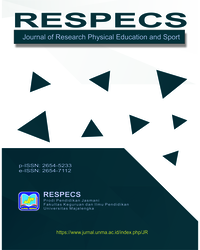Comparison of physical fitness characteristics of Japanese female basketball players by playing position and competition level
DOI:
https://doi.org/10.31949/ijobs.v2i2.6370Abstract
The purposes of this study were 1) to compare the physical fitness characteristics of Japanese female basketball players by position and 2) to compare the jumping ability of Japanese higher-competition and lower-competition level players. The subjects of this study were 13 Japanese female basketball players. The positions were categorized into three parts: guard for positions 1 and 2 (point guard and shooting guard), forward for positions 3 and 4 (shooting forward and power forward), and center for No. 5. The subjects were evaluated body mass, percentage of body fat, lean body mass, squat jump (SJ), countermovement jump (CMJ), rebound jump (RJ), 5m and 10m sprint, T-test, and 30-15 intermittent fitness test (30-15 IFT). This study was considered in the effect size (ES) due to the small sample size. The 90% confidence interval for ES of Hedge’s g was calculated to examine significant differences (p < 0.10). Guards were significantly higher SJ height and CMJ height than centers. Forwards had a significantly higher percentage of body fat than guards. Centers had significantly higher height, body mass, percentage of body fat, and lean body mass than guards. In addition, Centers had significantly higher lean body mass than forwards. Japanese seniors had significantly higher SJ height, CMJ height, and RJI than subjects of this study. Furthermore, Japanese U19 also had significantly higher SJ height, CMJ height, and RJI than the subjects of this study. This study showed that Japanese female basketball players differed in positional physical characteristics and competition-level jumping ability.
Downloads
References
Buchheit, M. (2020). The 30-15 intermittent fitness test. Retrieved 17/8 from https://30-15ift.com/
Comfort, P., Stewart, A., Bloom, L., & Clarkson, B. (2014). Relationships between strength, sprint, and jump performance in well-trained youth soccer players. J Strength Cond Res, 28(1), 173–177.
Delextrat, A., & Cohen, D. (2009). Strength, power, speed, and agility of women basketball players according to playing position. J Strength Cond Res, 23(7), 1974–1981.
Gonzalez, A., Hoffman, J., Scallin-Perez, J., & Fragala, M. (2012). Performance changes in National Collegiate Athletic Association Division I women basketball players during a competitive season: Starters vs. nonstarters. J Strength Cond Res, 26(12), 3197–3203.
Gottlieb, R., Shalom, A., & Calleja-Gonzalez, J. (2021). Physiology of Basketball - Field Tests. Review Article. J Hum Kinet, 77, 159–167. https://doi.org/10.2478/hukin-2021-0018
Hopkins, W., Marshall, S., Batterham, A., & Hanin, J. (2009). Progressive statistics for studies in sports medicine and exercise science. Med Sci Sports Exerc, 41(1), 3–13. https://doi.org/10.1249/MSS.0b013e31818cb278
Kawai, T., Sawamura, H., Kawai, A., & Aoyama, K. (1998). The specificity of force and power of leg muscle in the female basketball player (in Japanese). The Japanese journal of sport methodology, 11(1), 195–201.
Köklü, Y., Alemdaroğlu, U., Koçak, F., Erol, A., & Fındıkoğlu, G. (2011). Comparison of chosen physical fitness characteristics of Turkish professional basketball players by division and playing position. J Hum Kinet, 30, 99–106. https://doi.org/10.2478/v10078-011-0077-y
LaMonte, M., McKinney, J., Quinn, S., Bainbridge, C., & Eisenma, P. (1999). Comparison of physical and physiological variables for female college basketball players. J Strength Cond Res, 13(3), 264–270
Matsubayashi, T., & Inaba, Y. (2020). Fitness check data of Japanese top athletes (in Japanese). In T. Matsubayashi & J. s. council (Eds.), Fitness check handbook -Assessments of physical fitness in athletes- (pp. 163–383).
McGuigan, M. R., Sheppard, J., Cormack, S., & Taylor, K. (2013). Strebgth and power assessment protocols. In R. Tanner & C. Gore (Eds.), Physiological tests for elite athletes (2 ed., pp. 207-230).
Ohara, Y., Yoshino, A., Kiba, K., & Yamamoto, M. (2018). Method aimed at improving the competitive skill of university female basketball players by using subjective and objective evaluations (in Japanese). Research Journal of Sports Performance, 10, 334–353.
Santos, E., & Janeira, M. (2012). The effects of resistance training on explosive strength indicators in adolescent basketball players. J Strength Cond Res, 26(10), 2641–2647.
Scanlan, A., Dascombe, B., Reaburn, P., & Dalbo, V. (2012). The physiological and activity demands experienced by Australian female basketball players during competition. J Sci Med Sport, 15(4), 341–347. https://doi.org/10.1016/j.jsams.2011.12.008
Sugahara, M., Yoshimoto, O., Tahara, Y., Hirata, F., Yukawa, K., & Hasegawa, R. (1983). Training and conditioning of a women's basketball team -Change of physique, physical strength and hematological findings for a one-year period- (in Japanese). Bulletin of the Faculty of Liberal Arts, Nagasaki University. Natural science, 2, 23–32.
Tanigawa, S., Tachiyama, K., Kashiwakura, H., Okura, T., & Yoshida, T. (2022). The daily conditioning data and the results of physical fitness tests in preparatory period of women’s basketball team. ~ focus on the bilateral difference of leg strength ~ (in Japanese). Journal of Sport and Physical Education Center, University of Tsukuba, 44, 19–29.
Turner, A., & Jeffreys, I. (2010). The stretch-shortening cycle: Proposed mechanisms and methods for Enhancement. Strength Cond J, 32(4), 87–99.
Wirth, K., Hartmann, H., Sander, A., Mickel, C., Szilvas, E., & Keiner, M. (2016). The Impact of Back Squat and Leg-Press Exercises on Maximal Strength and Speed-Strength Parameters. J Strength Cond Res, 30(5), 1205–1212. https://doi.org/10.1519/JSC.0000000000001228
Yamada, H., Koyama, T., Kunitomo, R., Nagao, H., Mimura, M., Ogawara, K., & Rikukawa, A. (2015). The movement distance and moving velocity during a game in the japanese top-level girls basketball player (in Japanese). Tokai J. Sports Med. Sci, 27, 29–36.
Ziv, G., & Lidor, R. (2010). Vertical jump in female and male basketball players-A review of observational and experimental studies. J Sci Med Sport, 13(3), 332–339. https://doi.org/10.1016/j.jsams.2009.02.009
Published
How to Cite
Issue
Section
License
Copyright (c) 2023 Junpei Shiba

This work is licensed under a Creative Commons Attribution-ShareAlike 4.0 International License.

.png)

